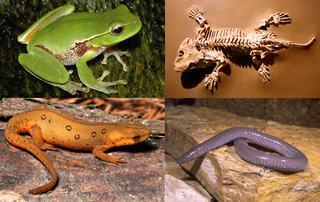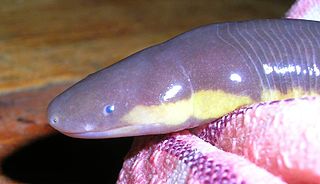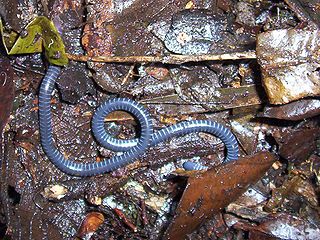
Amphibians are ectothermic, tetrapod vertebrates of the class Amphibia. All living amphibians belong to the group Lissamphibia. They inhabit a wide variety of habitats, with most species living within terrestrial, fossorial, arboreal or freshwater aquatic ecosystems. Thus amphibians typically start out as larvae living in water, but some species have developed behavioural adaptations to bypass this.

Caecilians are a group of limbless, vermiform or serpentine amphibians. They mostly live hidden in the ground and in stream substrates, making them the least familiar order of amphibians. All modern caecilians and their closest fossil relatives are grouped as a clade, Apoda, within the larger group Gymnophiona, which also includes more primitive extinct caecilian-like amphibians. Caecilians are mostly distributed in the tropics of South and Central America, Africa, and southern Asia. Their diet consists of small subterranean creatures such as earthworms.

The Batrachia are a clade of amphibians that includes frogs and salamanders, but not caecilians nor the extinct allocaudates. The name Batrachia was first used by French zoologist Pierre André Latreille in 1800 to refer to frogs, but has more recently been defined in a phylogenetic sense as a node-based taxon that includes the last common ancestor of frogs and salamanders and all of its descendants. The idea that frogs and salamanders are more closely related to each other than either is to caecilians is strongly supported by morphological and molecular evidence, they are for instance the only vertebrates able to raise and lower their eyes, but an alternative hypothesis exists in which salamanders and caecilians are each other's closest relatives as part of a clade called the Procera, with frogs positioned as the sister taxon of this group.

Rhinatrematidae is a family of caecilians, also known as the Neotropical tailed caecilians, American tailed caecilians. or beaked caecilians. They are found in the equatorial countries of South America.

The Ichthyophiidae are the family of Asiatic tailed caecilians or fish caecilians found in South and Southeast Asia as well as southernmost China.

Uraeotyphlus is a genus of caecilians in the family Ichthyophiidae. There are seven species in this genus, all of which are endemic to the Western Ghats of southwestern India. Previously, the genus has also been placed in its own monotypic family Uraeotyphlidae.
The Scolecomorphidae are the family of caecilians, also known as tropical caecilians, buried-eyed caecilians, or African caecilians. They are found in Cameroon in West Africa, and Malawi and Tanzania in East Africa. Caecilians are legless amphibians which superficially resemble worms or snakes.

Caeciliidae is the family of common caecilians. They are found in Central and South America. Like other caecilians, they superficially resemble worms or snakes.

Boulengerula taitana is a species of caecilian. It is endemic to the Taita Hills region of southeast Kenya.

Boulengerula niedeni, the Sagalla caecilian, is a worm-like amphibian first described in 2005. The species was described from a specimen discovered on Sagala Hill, an isolated mountain block of the Taita Hills in Kenya, and is not known from other areas.
Boulengerula changamwensis, the Changamwe caecilian, is a species of amphibian in the family Herpelidae. It is also known as Changamwensis African caecilian and Changamwe lowland caecilian. It is found in southern Kenya and Malawi, and possibly in the intervening Tanzania and Mozambique.
Boulengerula denhardti is a species of amphibian in the family Herpelidae. It is endemic to Kenya. It is only known from its type locality, the Tana River valley, as well as from the Ngaia Forest, Meru County. It is named for German explorer brothers Clemens Denhardt and Gustav Denhardt who explored the area where it was discovered. Its natural habitats are subtropical or tropical moist lowland forests and heavily degraded former forest. It is threatened by habitat loss, expanding agriculture, use of herbicides and pesticides and expanding human settlements.
Boulengerula fischeri is a species of caecilian in the family Herpelidae. It is endemic to Rwanda and only known from around its type locality near Cyangugu, southwestern Rwanda. The specific name fischeri honours Eberhard Fischer, a German botanist who has worked with Rwandan fauna and flora. Common name Fischer's African caecilian has been coined for it. Live animals have the appearance of "live pink spaghetti".
Herpele multiplicata is a species of caecilian in the family Herpelidae. It is endemic to Cameroon. It is only known from its holotype, which is now lost. The only available information is the brief species description published in 1912 by Fritz Nieden. Common name Victoria caecilian has been coined for it.

Herpele is a genus of caecilians in the family Herpelidae. They are endemic to Central and Western Africa.

Herpele squalostoma is a species of caecilian in the family Herpelidae. It is also known by the common name Congo caecilian. It is found in Central and extreme easternmost West Africa.

Siphonops annulatus, the ringed caecilian, is a species of caecilian in the family Siphonopidae from South America. It might have the broadest known distribution among terrestrial caecilian species.

Herpelidae are a family of caecilians, sometimes known as the African caecilians. They are found in Sub-Saharan Africa. Like other caecilians, they superficially resemble worms or snakes. They are the sister group to the newly discovered Chikilidae.
Fritz Nieden was a German zoologist who specialized in African herpetology.
Boulengerula spawlsi is a species of caecilian in the family Herpelidae. It is endemic to Kenya and only know from the vicinity of its type locality, Ngaia Forest Reserve, in the Nyambene Hills, Meru County; the type locality is also spelled "Ngaya" or "Ngaja". The specific name spawlsi honours Stephen Spawls who first collected this species and who has contributed substantially to African herpetology. Common name Spawls' boolee has been coined for it.











